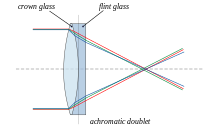
Back عدسة لالونية Arabic འའདུམ་པར་བྱེད་མཁན་གྱི་ཤེལ། Tibetan Achromát Czech Achromat German Akromata lenso Esperanto Lente acromática Spanish Akromaatiline lääts Estonian Doublet achromatique French עדשה אכרומטית HE Apokromat Croatian



An achromatic lens or achromat is a lens that is designed to limit the effects of chromatic and spherical aberration. Achromatic lenses are corrected to bring two wavelengths (typically red and blue) into focus on the same plane. Wavelengths in between these two then have better focus error than could be obtained with a simple lens.
The most common type of achromat is the achromatic doublet, which is composed of two individual lenses made from glasses with different amounts of dispersion. Typically, one element is a negative (concave) element made out of flint glass such as F2, which has relatively high dispersion, and the other is a positive (convex) element made of crown glass such as BK7, which has lower dispersion. The lens elements are mounted next to each other, often cemented together, and shaped so that the chromatic aberration of one is counterbalanced by that of the other.
In the most common type (shown), the positive power of the crown lens element is not quite equalled by the negative power of the flint lens element. Together they form a weak positive lens that will bring two different wavelengths of light to a common focus. Negative doublets, in which the negative-power element predominates, are also made.